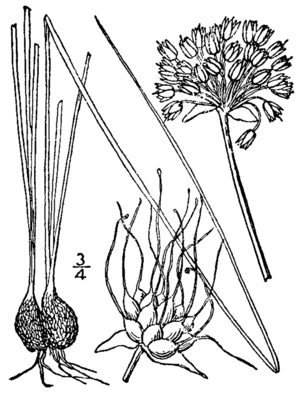Canada onion facts for kids
Quick facts for kids Canada onion |
|
|---|---|
 |
|
 |
|
| 1913 drawing | |
| Scientific classification | |
| Synonyms | |
|
The Canada onion (also called Canadian garlic, wild garlic, or wild onion) is a type of plant that grows year after year. It is native to eastern North America, from Texas to Florida and up to New Brunswick and Montana. People also grow this plant in other places because it looks nice or for cooking. It has even started growing wild in Cuba.
Contents
What Does the Canada Onion Look Like?
The Canada onion has an edible bulb, which is like a small onion you can eat. This bulb is covered with tough, brown fibers. The plant smells and tastes strongly like an onion. Another plant, crow garlic (Allium vineale), looks similar but tastes more like garlic.
The plant has long, narrow leaves that look like grass. They grow near the bottom of the stem. At the top of the stem, you'll find a round bunch of star-shaped flowers. These flowers can be pink or white. Sometimes, tiny bulblets (small bulbs) grow instead of flowers.
When flowers are present, they have both male and female parts. American bees and other insects help to pollinate them. The Canada onion usually blooms in spring and early summer, from May to June.
Different Kinds of Canada Onion
Scientists recognize several different kinds, or varieties, of the Canada onion. One common type is called A. canadense var. canadense. This variety often grows small bulblets instead of many seeds.
You might have heard of the tree onion. It was once thought to be related to the Canada onion. However, we now know that the tree onion is a mix of the common onion and the Welsh onion.
Here are some of the main varieties of Canada onion:
- Allium canadense var. canadense: This type mostly grows bulblets instead of seeds. It is found across most of the plant's range.
- Allium canadense var. ecristatum: This variety has thick, deep pink flowers. It grows along the coast of Texas.
- Allium canadense var. fraseri: This type has white flowers. It is found in the Great Plains, from Texas to Kansas.
- Allium canadense var. hyacinthoides: Its flowers are pink, thin, and smell nice. You can find it in northern Texas and southern Oklahoma.
- Allium canadense var. lavandulare: This variety has lavender-colored flowers that do not smell. It grows from northern Arkansas to South Dakota.
- Allium canadense var. mobilense: This type has lilac-colored flowers and thin stems. It is found in the southeastern United States.
How People Use Canada Onion
The Canada onion is grown as a vegetable in home gardens in Cuba. Long ago, Native Americans and early European settlers gathered it from the wild to eat. Today, people in the Cherokee Nation still pick and cook wild onions in early spring.
Native American tribes also used the plant for other things. For example, they would rub the plant on their bodies. They believed this would protect them from bites from insects, lizards, scorpions, and tarantulas.
You can eat the whole Canada onion plant raw, but you might want to remove the tougher outer layers. It can also be cooked and used in any recipe that calls for onions. The plant has a clear onion smell. If a plant you find doesn't smell like onion, it might be a poisonous plant called deathcamas. So, always be careful!
It's important to know that eating parts of this plant can cause stomach upset in young children. Also, eating too much of the bulbs over a long time can affect the thyroid gland. This gland helps control how your body uses energy. If someone eats too much, doctors usually suggest keeping them hydrated. Farm animals like horses can also get sick from eating wild onion leaves. It can even cause a blood problem called hemolytic anemia in horses.
See also
 In Spanish: Allium canadense para niños
In Spanish: Allium canadense para niños

